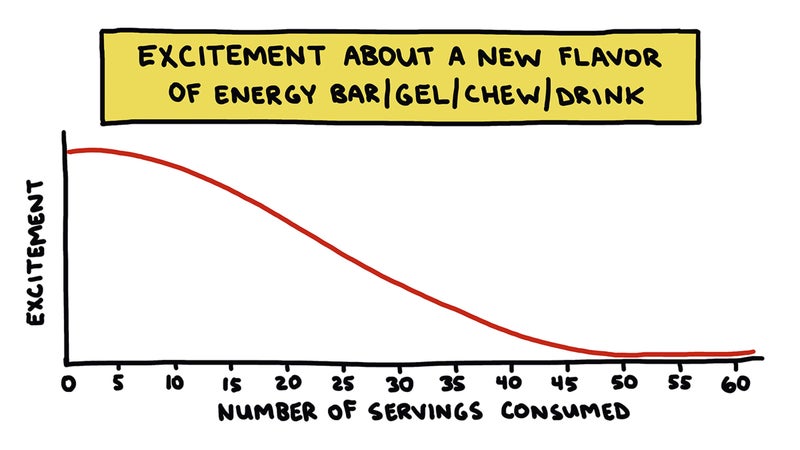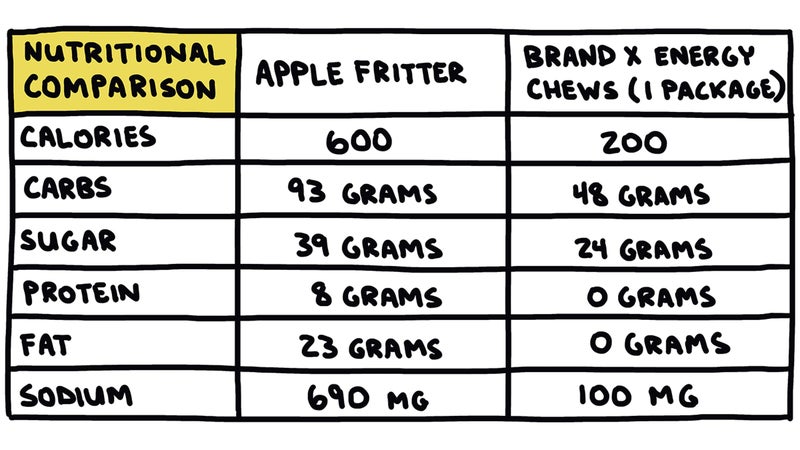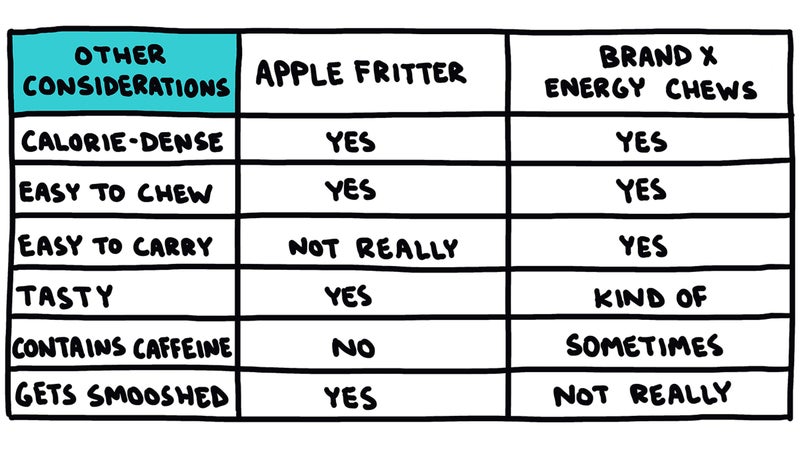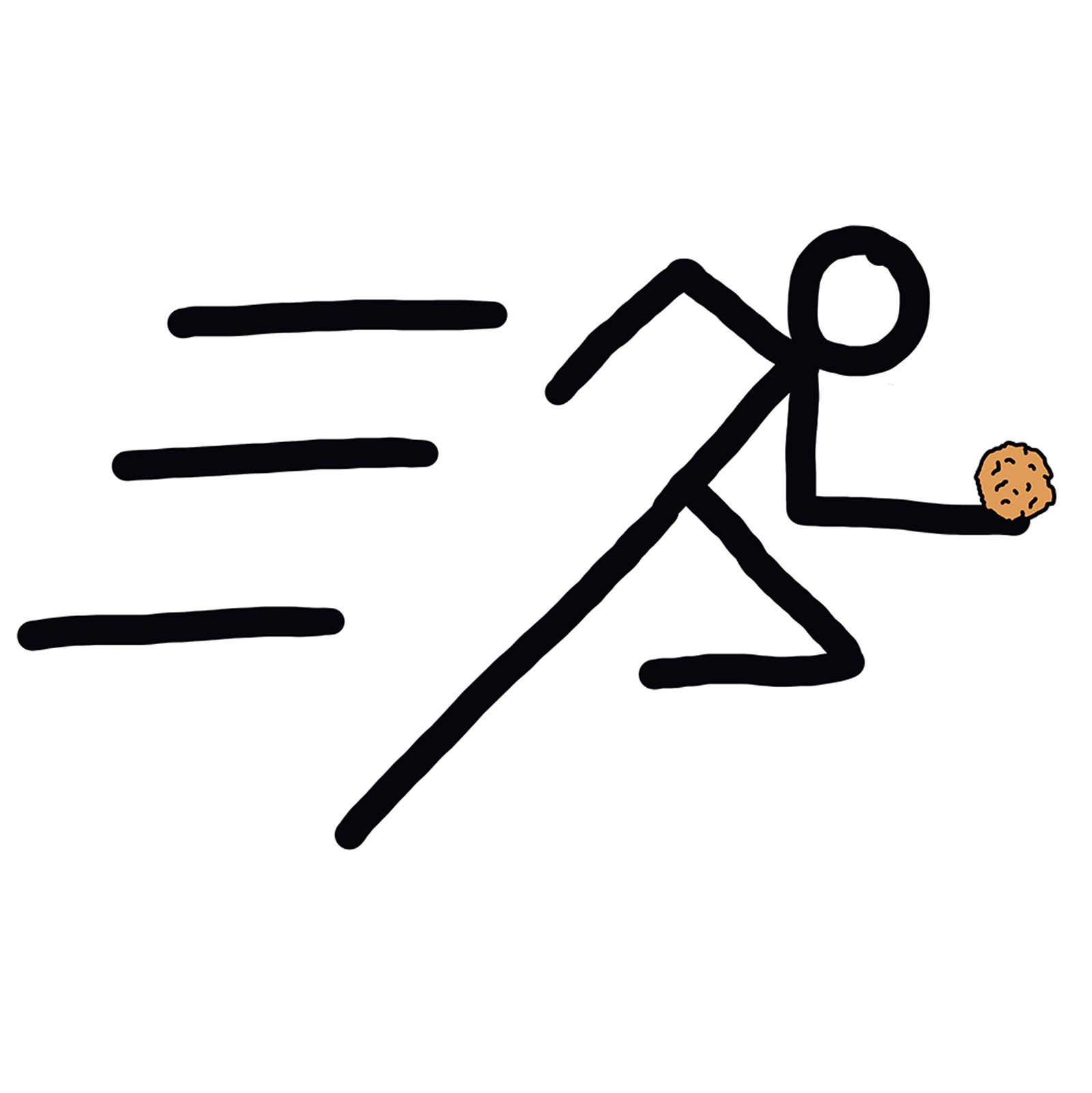At about mile 13 of the , I was starting to feel hungry. I did the math in my head—I had about 14 miles of running left, and one remaining package of Clif Bloks. I could very probably make it to the finish line on those Clif Bloks, plus maybe a couple pieces of banana and/or a Honey Stinger gel handed out by volunteers. And that would be fine.
Or, I could run into Winchell’s, which was literally less than 100 feet off the race course just after mile 17, and get an apple fritter. And that would be much tastier.
Look: I have nothing against “space food,” the stuff we commonly eat while doing endurance events. I have consumed hundreds of gels, blocks, and waffles, and thousands of ounces of electrolyte drinks. They do the job, and lots of them taste pretty good, or decent enough that you don’t hate them until you’ve eaten about 50 of them over the course of a few months or a year and you just get sick of them. A non-scientific chart of enjoyment of space food products might look like this:

This is no fault of energy bar companies—they do great work, and I applaud them for that. But when your product is designed to be sold to people doing really uncomfortable things, you can’t expect those people to make lifelong commitments to your Lemon-Lime flavor of energy semi-solids. Pizza or ballpark hot dogs are a much easier sell: both are most often associated with positive memories. You eat pizza while having good times with your friends, a ballpark hot dog while at a game with your family—not while exerting yourself for four to 36 hours on a bicycle or running trail, cramming calories into your mouth more to avoid bonking than for any sort of epicurean enjoyment.
Energy foods, on the other hand, are harder to associate with positive memories. You don’t cross a finish line, high-five your friends and family, gather yourself, and then sit down at a restaurant to look over the menu and then decide maybe you’ll just have a few more of those tasty energy globules and gels instead of a plate of nachos or a cheeseburger. Hell no you don’t. You smash that cheeseburger. And the nachos.
But those energy foods have served their purpose, which, as far as my personal research goes, is two-pronged: a) they provide readily available caloric fuel so you can continue moving, and b) they don’t make you shit your pants while exercising. If you do enough endurance activities, you probably have used your own trial-and-error process to figure out what meets both a) and b), and have a few things you rely on fairly regularly.
OK then. But have you ever eaten an apple fritter in the middle of an endurance activity? If you haven’t, I recommend it, as part of your trial and error process. (If it causes the aforementioned digestive issues, obviously the rest of this piece is not going to be relevant for you.) I’m not saying you should eat one every time you go out for a run longer than 10 miles or a bike ride longer than 30 miles, but every once in a while, it’s pretty damn good for morale. And, of course, good for calories, require to sustain life.
Nowadays, if you have an idea about nutrition, you can probably find an article or study out there to support it, or at least someone with a pretty large social media following. For longer-distance events, lots of smart people agree that a human body requires carbohydrates—which you can find in apple fritters and energy blocks alike:

Some experts think a small amount of protein is good , some don’t. Most experts agree that electrolytes need to be replaced during endurance events, especially if you’re sweating heavily—and our friend the apple fritter contains 690 milligrams of sodium, or a little more than twice the amount in a single serving of Tailwind.
Note that an entire apple fritter contains 600 calories, which is probably way too many to eat all at once while running or cycling, no matter who you ask. I suggest eating half of the apple fritter, or 300 calories. Splitting it with a friend is ideal, as the portability of an apple fritter is a bit limited, at least when compared to energy chews. But it is possible to carry an apple fritter in a bag for quite a while, or at least until you’re hungry again. This all depends on motivation and your personal dedication to that fritter.

As we approached mile 17 of the Colfax Marathon, I pulled my credit card from my pocket and held it in my hand, so at least it wouldn’t be covered in sweat when I handed it to the cashier at Winchell’s. A few hundred feet from the building, I picked up my pace a bit, hoping to gain a few seconds and compensate for the net loss of time I’d experience in the donut shop. I popped through the door, delighted to see no line, and ordered an apple fritter. Less than 60 seconds later, I was back outside, jogging with my bagged pastry. For a time comparison, when I stopped at a port-a-potty at mile four, my total time including a wait behind four people was about two minutes and 30 seconds.
I re-joined my wife and we continued our previous pace. I slid the fritter out of the bag and took bites as we ran, downing half of it in about a half-mile of running. It was fresh, soft, sweet, and didn’t have the overly-fried taste that some apple fritters have.
We finished the race feeling relatively strong, and I clocked my second-best marathon time ever, using a combination of energy blocks and a donut. Now, was this a well-designed, controlled experiment? No. Does this offer any proof besides anecdotal evidence that apple fritters can work as endurance fuel? Also no.
Could you, however, through your own trial-and-error process, decide if apple fritters are right for you? Yes. If you don’t really like apple fritters, could you use another donut in its place? Hey, this is a free country—you can attempt an Ironman triathlon with a turkey leg in your hand if you want to. All I’m saying is there are other options beyond traditional endurance foods, including donuts.


